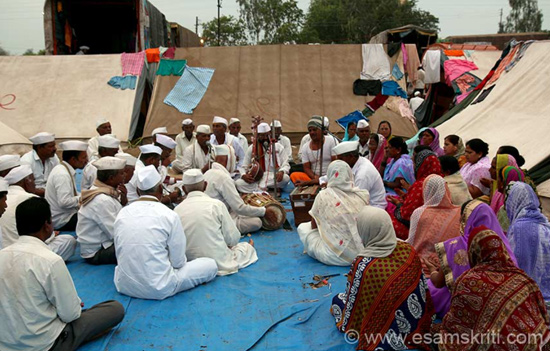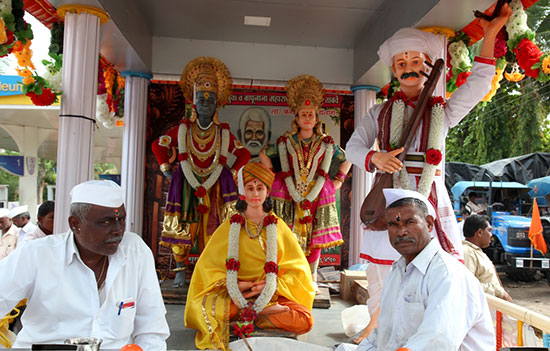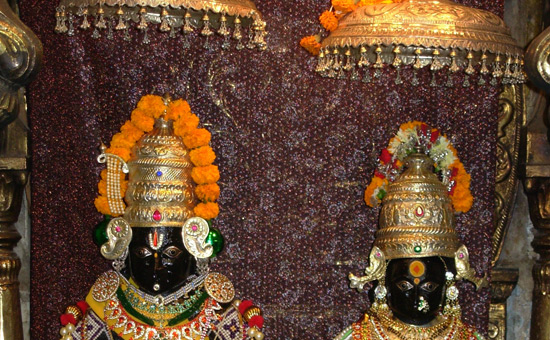- Know
about the life and thoughts of Sant Dynaneshwar, lived only 21 years, his works
and philosophy. He added Bhakti as the fifth aim of human life.
Sant
Jnanesvara, called also Jnanadeva, Dnyanadeo and Dnyanoba (1275-1296) was the
pioneer of Bhakti movement in Maharashtra.
Born
at Alandi (district Pune) in 1275, the son of Vitthalpant Kulkarni of Apegaon,
a village near Paithan on the banks of the Godavari, and his wife Rakhumabai
(Rukmini), he hailed from a family of devouts. His great grandfather
Tryambakapant and his grandparents, Govindpant and Nirabai were initiated into
the Natha sect by Guru Gorakshanatha and Guru Gahininatha respectively. His
father, Vitthalpant, after getting married went to Banaras and took to sannyasa
without the knowledge of his preceptor, Ramasrama, who on learning about this
fact, directed him to return to the life of a householder, which he did. But
the orthodox brahmins of Alandi excommunicated him and asked him to atone for
his sins by giving up his life at Prayaga (Allahabad), the confluence of Ganga,
Yamuna and Sarasvati (now extinct). Vitthalpant obeyed the directive leaving
behind his three sons, Nivruttinath (1273-1297), Jnanesvara (1275-1296),
Sopanadeva (1277-1296) and, daughter Muktabai (1279-1297), in utter isolation.
To
remove the blot of apostasy, Jnanesvara along with his brothers and sister
moved to Paithan (district Aurangabad) to plead their case with the learned Brahmins.
Tradition says that when he was rebuffed, he confounded the Jury by his
spiritual erudition and by performing miracles such as making a buffalo chant
the Vedic hymns, and, thereafter, received due recognition. On his way back to
Alandi he halted at Nevase in Ahmadnagar district where, in a small temple on
the banks of the river Pravera, (Prawara) he dictated to Sacchidananda Baba, a
commentary on the Bhagavad Gita in
Marathi in 9000 ovis. It was completed in 1290 CE as mentioned in the work
itself. A stone pillar stands at the site of dictation. The work remained in
manuscript form for three centuries till Sant Ekanatha
(1533-1599) prepared an authentic text to safeguard it from interpolations.
First published in
Journal of Bharatiya Vidya Bhawan.
After
returning to Alandi on the left bank of the Indrayani, Jnanesvara eclipsed the
yogi Changadeva, known for his supernatural feats. As per tradition when the
Yogi approached him by riding a tiger with a snake for a whip, Jnanesvara made
the wall on which he was seated, move in his direction, and humbled his pride.
The wall was rebuilt in stone in 1898, and is the object of worship to this
day.
Sometime
in 1293, Jnanesvara visited Pandharpur where he came into contact with Sant
Namadeva (Namdeo) and developed spiritual affinity with him. Together, they
went on pilgrimage to Banaras and other holy cities in the north, meeting
people, holding congregations and performing kirtana - the rendering of
devotional songs with musical instruments. Many holy personages like Goroba, the potter, Savata; the gardener, Chokha (Chokhamela; Chokhoba), the pariah, Narahari; the goldsmith and Parisa Bhgavata, the Brahmin, besides Jnanesvara’s kin, accompanied the religious group.
After
returning to Pandharpur on the bright eleventh (ekadashi) of Kartika in 1296,
Jnanesvara observed the religious festivities of the Varakaris on the full-moon
day. Thereafter, he had an intuitive feeling that his mission in life was
complete. He came back to Alandi along with his fellow-saints and took the sanjivana samadhi in which one
volunteers to entomb oneself alive in a meditative state. It was the thirteenth
day of the dark half of Kartika in 1296. Thousands of people from all over
India visit the site annually in the months of Ashadha (July-August) and
Kartika (November-December) to pay respectful homage to the saint who was
knowledge and bliss incarnate.
 Varkaris singing Bhajans, enroute to Pandharpur. 2015.
Varkaris singing Bhajans, enroute to Pandharpur. 2015.
Jnanesvara’s brothers and sister died less than two years after his death but they left a deep mark on the life of people in Maharashtra and created a niche for themselves in religious circles. Sopanadeva (Sopandeo) was the first to leave his mortal coil followed by Muktabai and Nivruttinatha. Their samadhis which are thronged by devotees to this day lie respectively at Sasavada (district Pune), Edalabada (district Jalgaon) and Trymbakesvara (district Nasik).
Nivruttinatha who had learnt
the fundamentals of the Natha sect from Guru Gahininatha at Brahmagiri (near
Nasik in Maharashtra) initiated Jnanesvara, Sopnadeva and Muktabai. They, in
turn, set the tone for the spread of Bhakti movement by composing religious ballads
(abhangas), popularising devotional
singing, the kirtana, and initiating others. Sopanadeva provided spiritual
guidance to Visoba Khechara, the preceptor of Sant Namadeva. Muktabai taught
the Way Divine to the yogi Changadeva after he had been humbled by her brother,
Jnanesvara, who is acclaimed as the first saint and prophet of Maharashtra.
Works
An
intellectual mystic, the ideas of Jnanesvara were shaped by the Upanishads, the
Bhagavad Gita, the Yoga Vasistha, the Siva Sutras and the Advaita philosophy of
Sankaracharya and he blended them all in the light of his own spiritual
explorations to produce his magnum opus, the Jnanesvari (Dnyanesvari) and other works namely the Amritanubhava, Changadeva-Pasasthi, Haripatha,
Namana and abhangas.
Jnanadevi and Bhavartha-Dipika, ranks among the world’s finest mystical outpourings. It harmonises the paths of Karma (action), Jnana (knowledge of the self) and Bhakti (devotion to the supreme) employing similes and metaphors to explain moot philosophical points. ‘By this attempt of mine’, he wrote, ‘let the want of self-knowledge be removed. Let the need of everyone who wants to experience this infinite store of spiritual joy, be met’. He stated that the Vedas savoured by the twice-born embodied themselves again in the form of the Bhagavad Gita so that even an ordinary person could quench his spiritual thirst (Jnanesvari XIII-11-55; XVIII-1447- 50). The Jnanesvari continues to have a universal appeal due to its high literary quality, homely style, philosophical depth, catholicity and devotional content.
In
Amritanubhava, ‘experience of the nectar’, Jnanesvara delves on the oneness of Siva
and Sakti and of Vishnu (Hara) and Shiva (hari) comparing them to the sun and its motion or gold and its lustre (I, 25.41; IX.62). He refutes Ajnanavada, the doctrine of unawareness, explains the secrets of natural devotion and exhorts people to feel oneness with the Supreme Being. ‘The bloom of youth resides in a damsel but it blossoms forth when she is united with her beloved’ (x.22). Changadeva-Pasashti, the sixty-five verses addressed to Yogi
Changadeva dilate on the non-dualistic
philosophy in which the triad of knowledge, knower and the known are identical.
Haripatha comprising twenty-eight
verses explains the significance of remembering the Name of the Lord Hari. Namana, containing one hundred and eight
verses reflects on the power of prayer. The abhangas of Jnanesvara, about one
thousand in number, explore a number of philosophical subjects besides
glorifying the god Vithal, and are sung by the Varakaris with filial devotion
to this day. The insinuation of some scholars that the authors of Jnanesvari
and the abhangas are different persons cannot be substantiated.
 Centre of pic is Sant Dynaneshwar, Pandharpur. 2015
Centre of pic is Sant Dynaneshwar, Pandharpur. 2015
Philosophy
Jnanesvara breathed fresh life into the decadent dharma of his time by combining the doctrine of Advaita (monism) with that of Bhakti saturated with mystical insights. His devotional monism was not pedagogical but the result of a deep religious experience. While in search of the Reality he came to embody the Reality himself and, thenceforth, spoke and wrote from a state of heightened consciousness to enlighten humanity. In Amritanubhava (X.3-4) he says, “Was it for the moon’s sake that the nectar was given to her? Or did the sea grant water to the clouds for their own use? The expanse of the sky is for the sake of the whole world.”
To Jnanesvara, the Ultimate Reality is one; finite selves are also the Universal Self and free from birth and death. The individual suffers on account of his identification with the body. ‘The senses that rub their mouths on the barren land of sensual objects, cannot taste the sweetness in the Atman’, he wrote (Amritanubhava, VII.111)
Jnanesvara
saw the play of the pure intelligent Atman all over the Universe and refuted the concept of Maya so ably propounded by Shankaracharya. He held that God contains his own being within himself. God is the Absolute Truth. The pure Intelligence underlies varied forms and sights, yet its unity is not lost. The world is His sport and He plays happily with Himself as ‘the eternal perceiver’ and ‘the eternally perceived’. There is no difference between the Absolute Reality and the world of phenomena. All that exists is illuminated by His light. “The sun sees everything. But is it possible for him to witness the beauty of his own rising and setting,” he asks and then provides a philosophic answer, “Being the vision itself, He does not know seeing and not seeing. He himself is the cause of both.” (Amritanubhava, VII.135, 157,195,197) Jnanesvara thus expounded the concept of sphurtivada which
regards existence as a luminous appearance.
Jnanesvara
saw no dichotomy between knowledge (Jnana) and ignorance (ajnana) as he argued
that both are destroyed in the process of giving them separate meaning. If the
knowledge requires the aid of another knowledge, it is nothing but ignorance
(Amritanubhava, IV 23). Ignorance is a product of maya which in the sense of
illusion, can neither coexist with knowledge nor can stand of its own. Maya is
not a separate entity but the creative power of the Lord. Avidya (nescience) being non-existent, cannot be dispelled nor does Atma, being self-evident, require any proof. Jnanesvara gives many examples to prove his point. “If the hand is stretched out to gather the ripples it gets nothing but water. The parts that appear in the sugarcane are all contained in the juice; the full moon has all its lustre....... If the moon tried to gather the moonlight then who has gathered what?” (Amritanubhava, IX.13.18.26)
Jnanesvara
held that the Ultimately Reality cannot be fully
described as it transcends the orbit of linguistics. In Amritanubhava (V1.91) he asks, “The tip of the tongue is expert in tasting the different flavours. But can it taste itself?” Even the enlightened ones fall short of words. ‘How can words describe the Reality where the Supreme Speech itself disappears and no trace is found of any sound?’ (V.63). In a mystic experience of union with the Divine, God himself becomes, the devotee; the destination becomes the path and, the speech becomes the deepest silence. Who meets whom? He asks, “How can the eyesight be opened when even the unity is dissolved?” Thenceforth, image-worship initially required for concentration on the divine loses its meaning. “Do they plough the field when there is the harvest?” (X.35,17,VII.122,V.65).
To
the list of traditionally prescribed aims of human life (purushartha) namely Dharma, Artha, Kama and Moksha, Jnanesvara added a fifth-Bhakti. He regarded the chanting of God’s name and singing His praises as the royal road to realisation. It gives one spiritual insight and a sense of fulfilment. Yet God is not the other but the true self of a devotee. The sign of true devotion is to understand God as He really is.
 Vitthal of Pandharpur. Pranams.
Vitthal of Pandharpur. Pranams.
Wordly
knowledge is of no meaning without the knowledge of the Self, and the best way
to acquire it is through unswerving devotion to the only ontological reality.
Bhakti is a matter of love (prema) and love is God himself. It is the quality
of love to express itself and the cosmos is nothing but its veritable
expression. Jnanesvara regarded Vitthal as the
supreme symbol of love, the embodiment of Existence, Knowledge and Bliss. He is both ‘with attributes’ (saguna) and ‘without attributes’ (nirguna). The summum bonum of man’s life is not emancipation (mukti) from the bondages of the world but the experience of the divine bliss. But Bhakti is not something external; it is the very essence of man. And man is god himself. ‘So not only he worships while worshipping, but also does the same while not worshipping.’ (Amritanumbhava IX.49).
He who knows the Reality loves others as his own selves. Love breeds in him equanimity and fellow feeling and releases him from the sense of ‘I’ and ‘myness’. The glory of God is the glory of man. Guru or the preceptor alone shows the way Divine. He turns bondage into liberation. Both in the Jnanesvari (viz chapters I, VI, X, XVI) and in the Amritanubhava (Chapter II), Jnanesvara praises his spiritual teacher and elder brother, Nivrittinatha by whose grace he experienced the supreme bliss.
Sant
Jnanesvara was a prophet of Bhakti who brought about a spiritual renaissance in
Maharashtra. He has also been called the father of
Marathi literature and of Marathi nationalism although he neither
aspired nor claimed to be so and remained a true and humble devotee of the lord
during his short life-span of about 22 years, attributing his extraordinary
spiritual and mental powers to the self-luminous divinity
This article was first published in the Bhavan’s Journal, February 28, 2017 issue. This article is courtesy and copyri ght Bhavan’s Journal, Bharatiya Vidya Bhavan, Mumbai-400007. eSamskriti has obtained permission from Bhavan’s Journal to share. Do subscribe to the Bhavan’s Journal – it is very good.
To read all
articles by Dr Satish K Kapoor
Also read
1.
About
Swami Ram Tirtha
2.
Ramanuja
3.
Ekanath
the Reformer 16th century
4.
Rajrishi
Bhagyachandra and Bhakti of Manipur
5.
Life
of Sant Tulsidas
6.
Lives
of Indian Saints
7.
About
Agastya Muni
8.
Vithoba
of Pandharpur
9.
Pandharpur
Wari album
10.
Another
article on Sant Dynaneshwar
11.
Asha
Ekadasi and the Warkari Movement